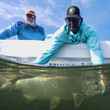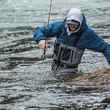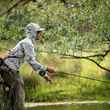Despite the vast array of hip/lumbar packs that have been on the market over the last handful of years, it is surprising how few actually end meeting expectations. Well, my expectations at least. And I've owned my share, from some of the best names in the business. Yet, even some of the packs I've owned from manufacturers that typically turn out well made, smartly functioning gear have fallen victim to many of the same pitfalls: inadequate construction quality, over-complicated design or poor wearability and/or on-the-stream usability (packs that seem great on the rack at the fly shop, but fail to deliver once they're on your hip and on the stream). So, when hip packs come along that do their job and do it well, they're worth talking about. Fishpond's Westwater Guide Lumbar pack is one of those.
The Westwater Guide Lumbar pack is part of Fishpond's Westwater collection of packs and bags, which all share the same aesthetics and design philosophy that revolves around the collection's heavy-duty construction, meant to take a beating and keep your gear dry. The construction of the Westwater collection is primarily 1680d TPU waterproof fabric, with water-resistant zippers securing all access points. It is important to note that the Guide Lumbar pack and the other bags in the Westwater collection are not waterproof, despite often being referred to as such. While the 1680d nylon the bags are almost wholly built out of is entirely waterproof, the zippers are not. The zippers are YKK #10 water-resistant zippers, not the YKK #5 Aquaseal or TZIP waterproof zippers found elsewhere. That said, you can expect a great deal of water resistance from these bags. I've fished in moderately heavy rain without concern, don't panic if the occasional dunking happens and my smartphone is inside and don't think twice about letting the bag get splashed, tossed down on boat floors and so on. It takes a bit of doing to get water into this bag, so it is going to keep things dry virtually all of the time, but please take care to understand these bags are not submersible.



























